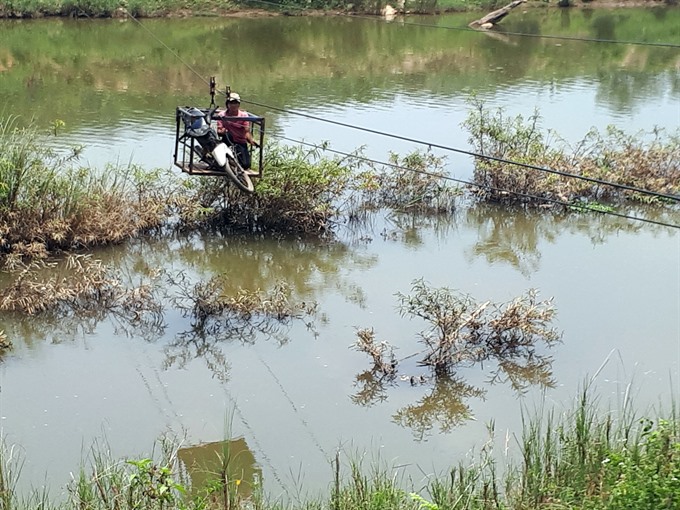KON TUM — Residents are putting their safety at risk every day crossing a river using a cable and pulley, even though there are two bridges nearby.
The banks of the Pô Kô River in Central Highland province of Kon Tum are connected by a suspension bridge and a concrete bridge, but some people are still using a 10-year-old pulley operated by two cable lines.
Many say it’s because they have to travel between five and 10 kilometres to use the constructed bridges, wasting valuable time and causing inconvenience.
But there are many risks associated with this type of crossing.
If overloaded, the iron cage stoops dangerously close to the water leaving commuters needing to pull ropes to get to the other side.
Local resident Đặng Trung Tá in Hamlet 3, Plei Kần Town in Ngọc Hồi District said his family installed the cable system to make a shortcut.
Tá said many families live in Ngọc Hồi District but their farming land was in Đắk Tô District on the other side of the river.
“For nearly a decade, local residents in Hamlet 3 use the cable to cross Pô Kô River,” Tá said. "They also used the cable to transport vehicles and farming products.”
Another resident in Hamlet 3, Lương Tám said his family had more than 4ha of farmland in Ngọc Tụ Commune, Đắk Tô District.
Despite being aware of the risks, he said he uses the system because it is a far more convenient way to travel to the field.
Trần Dương Chấn of the Đắk Rơ Nga Commune, Ngọc Hồi District said for a long time, people transported farm products and fertiliser by boats.
But he said during rainy season, boats could not cross the river because of strong water flow.
“If we don’t use the cable, we have to go about five kilometers to use a suspension bridge or even ten kilometers to use a concrete bridge,” Chấn said.
“After crossing the bridges, we drive on a rugged path which costs time and is very inconvenient,” Chấn said.
Locals say although no one has died because of the cable, two people did fall into the water last year after a cable snapped.
Chairman of Plei Kần Commune People’s Committee Nguyễn Xuân Phượng said residents built and used the river-crossing cable by themselves.
Phượng said the commune was asking local businesses to help by building a wooden bridge.
Using cable and pulley to cross river is not rare in Central Highland provinces in Việt Nam, especially in disadvantaged areas where firm bridges are not available.
In northern Điện Biên Province, in 2014, people from Sam Lang Village in Nà Hỳ Commune adopted an unusual and dangerous way to cross a swollen stream. The 100-metre trip is made by hopping into a large plastic bag and having it pulled by a strong swimmer in his shorts.
Tòng Thị Minh, a kindergarten teacher from the village, filmed a scene showing teachers waiting by the side of the swift-flowing stream. They then take it in turns to climb into a bag until it covers them from head to toe. Male swimmers then haul the "baggage" through the turbulent waters.
The residents, of course, try to stay calm during the trip because if the bags are torn on rocks, they face being swept away. Parents also use the bags to take their children to school.
Residents dream of a suspension bridge, but construction could be costly because of the difficult terrain and muddy roads.
According for Directorate for Roads of Việt Nam under Transport Ministry, this year, Việt Nam plans to build 776 new small bridges and complete the construction of nearly 1,000 bridges in disadvantaged remote areas with total investment of VNĐ 9.2 trillion (US$ 402 million ). — VNS
 Society
Society






